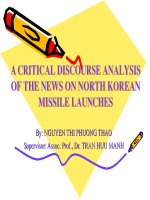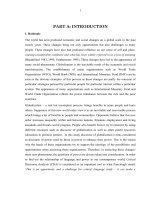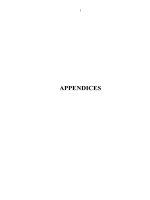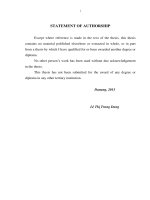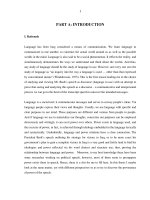A critical discourse analysis of I have a dream by Martin Luther King
Bạn đang xem bản rút gọn của tài liệu. Xem và tải ngay bản đầy đủ của tài liệu tại đây (616.44 KB, 6 trang )
A critical discourse analysis of "I have a
dream" by Martin Luther King
43tr.
Đặng Thị Anh Thư
Trường Đại học Ngoại Ngữ
Luận văn ThS. Chuyên ngành: English Linguistics; Mã số: 60 22 15
Người hướng dẫn: Prof. Nguyễn Hòa
Năm bảo vệ: 2010
Keywords: Tiếng Anh; Phân tích diễn ngôn; Ngôn ngữ học
Content:
PART A: INTRODUCTION
1. Rationale
Language plays a very important role in our life. We use language to communicate to
each other, to express our attitudes and ideology to the world around us and to the
social problems. To analyze language, there are many methods and approaches. Of
all, CDA approach is interested in linking linguistic analysis and social analysis. It is
applied to discover the relationship between language and social problems such as
dominance, power abuse, discrimination and etc. Norman Fairclough is the linguist
who has made a great contribution to CDA.
These years CDA has become favorite approach in language analysis and it really
interests me. When studying on linguistics, I have paid a lot of attention on the link
between language and social problems. And, one of them is discrimination in the
speech ‘I have a dream’ by Martin Luther King. This is one of twenty four speeches of
M. L. King and one of the most famous speeches in the world. It was delivered in
front of 250,000 people gathered by the Lincoln Memorial and millions more who
watched on television. Though it appeared in August 1963, it is still used in many art
works about freedom and equality. It also inspires people all over the world.
I am really interested in linguistics, especially CDA approach in analyzing the speech
to uncover the power hidden behind. Therefore, I decided to do a CDA study on ‘I
have a dream’ by Martin Luther King.
2. Scope of study
The study is beyond the scope of verbal aspects and social context when the speech
was delivered. Although paralinguistic factors such as intonation and stress, and
extra-linguistic factors such as facial expressions and eye contacts, are very
important in the speech, they are excluded in this study.
This research is linguistic study, and my own political view and my own support are
not expressed.
The paper mainly focuses on Transitivity and Modality which are used in the speech with
high frequency to uncover the relationship between the power, ideology and language.
3. Aims of study
The aims of the study are:
- To provide a support to the theory of CDA and SFG.
- To uncover the power and ideology hidden behind the speech ‘I have a dream’ by M. L.
King in the light of CDA and SFG.
- To offer some suggestions for teaching and learning language.
4. Significance
- The paper reaffirms the relationship between power, ideology and language.
- CDA is an effective approach to uncover the power and ideology hidden behind the text.
- The research is also a contribution to language teaching and learning.
5.
6. Methodology
The study uses CDA approach with three stages given by Norman Fairclough (2001) such as
description, interpretation and explanation. Besides, SFG by Halliday with three
metafunctions such as ideational function, interpersonal function, and textual function is
applied in the speech’s analysis.
The followings are the steps in analyzing the speech:
In the light of the theory of CDA and SFG, the relationship between power, ideology and
language is uncovered. First, the speech is divided into clauses. Second, it is analyzed in the
terms of vocabulary, grammar and textual structures, especially Transitivity, Mood, and
Modality. Third, the relationship between text and interaction is mentioned. Then,
the relationship between interaction and social context is shown to uncover the
power and ideology behind the speech.
7. Design of study
There are three main parts in this research paper.
Part A – Introduction
In Part A, the rationale, aims; scope, methodology, significance, and design of the
study are introduced.
Part B – Development
Part B consists of three smaller parts
1. Literature review
In Chapter 1, the brief introduction of M. L. King and the context of the speech will be
mentioned.
Chapter 1 gives out the theoretical background of CDA and SFG including brief
introduction of the history, definition and methodology.
2. A CDA of ‘I have a dream’ by Martin Luther King
In Chapter 2, the theory of CDA and SFG in Chapter 1 are applied in analyzing the
speech to uncover the relationship between power, ideology and language. In this
part, transitivity and modality of meta-functions are mainly focused.
3. Some suggestions for teaching and learning language
In Chapter 3, some suggested activities used to improve teaching and learning
language are mentioned.
Part C: Conclusion
1. Summary of findings
In this part, principal findings are summarized.
2. Suggestions for further studies
Suggestions for further research are given
REFERENCES
1. Chomsky, Noam (1957). Syntactic Structures. Paris: Mouton.
2. Fairclough, N. (2001). Language and Power (second edition). Harlow: Longman.
3. Fairclough, N., & Wodak, R. (1997). Critical discourse analysis. London: Sage
4. Halliday, M.A.K. (1994). Introduction to Functional Grammar. London: Edward Arnold.
5. Halliday, M.A.K (1971). Linguistic function and literary style: an enquiry into the
language of William Golding's 'The Inheritors'. New York: Oxford University Press.
6. Ha, N.M (2007). A Critical Analysis of President Bush’s Speech on the U.S Mission in Iraq
and his Policies in the Middle East. M.A Thesis. Hanoi: University of Languages and
International Studies – VNU
7. Hoang Van Van (2006). Introducing Discourse Analysis. Hanoi: Publishing House of
Education.
8. Hodge, R., Kress, G., (1993). Language as Ideology (2
nd
Edition). London: Routledge.
9.
10.
11.
12. Hymes, D. (1972). Models of the interaction of language and social life. In J. Gumperz
& D. Hymes (eds.), Directions in sociolinguistics: The ethnography of communication. New
York: Holt, Rinehart and Winston, pp. 35 71.
13. Janks, Hillary (1997). Critical Discourse Analysis as a research tool. In: Discourse:
Studies in the Cultural Politics of Education, 18(3), 329-342.
14. Kress, G and Hodge, B. (1979). Language as Ideology. London: Routledge.
15. Kress, G. (1990). Critical Discourse Analysis. In: Annual Review of Anthropology,
Vol.11, 84-97.
16. Levinson, Stephen C. (1983). Pragmatics. England: Cambridge University.
17. Nguyen Hoa (2006). Phân tích diễn ngôn phê phán: Lý luận và phương pháp. Hanoi:
VNU Press.
18. Nguyen Hoa (2003). Discourse Analysis: Some Theoretical and Methodological Issues.
Hanoi: VNU Press.
19. Van Dijk, T.A. (1985). A Handbook of Discourse Analysis. London: Academic Press.
20. Wodak, R. (1989). ‘Introduction’. In: R. Wodak. Language, Power and Ideology.
Amsterdam: Benjamins.




